Costa Rican vs Immigrants from Costa Rica Community Comparison
COMPARE
Costa Rican
Immigrants from Costa Rica
Social Comparison
Social Comparison
Costa Ricans
Immigrants from Costa Rica
5,399
SOCIAL INDEX
51.5/ 100
SOCIAL RATING
177th/ 347
SOCIAL RANK
3,937
SOCIAL INDEX
36.9/ 100
SOCIAL RATING
208th/ 347
SOCIAL RANK
Immigrants from Costa Rica Integration in Costa Rican Communities
The statistical analysis conducted on geographies consisting of 194,990,637 people shows a very strong positive correlation between the proportion of Immigrants from Costa Rica within Costa Rican communities in the United States with a correlation coefficient (R) of 0.889. On average, for every 1% (one percent) increase in Costa Ricans within a typical geography, there is an increase of 0.566% in Immigrants from Costa Rica. To illustrate, in a geography comprising of 100,000 individuals, a rise of 1,000 Costa Ricans corresponds to an increase of 566.3 Immigrants from Costa Rica.
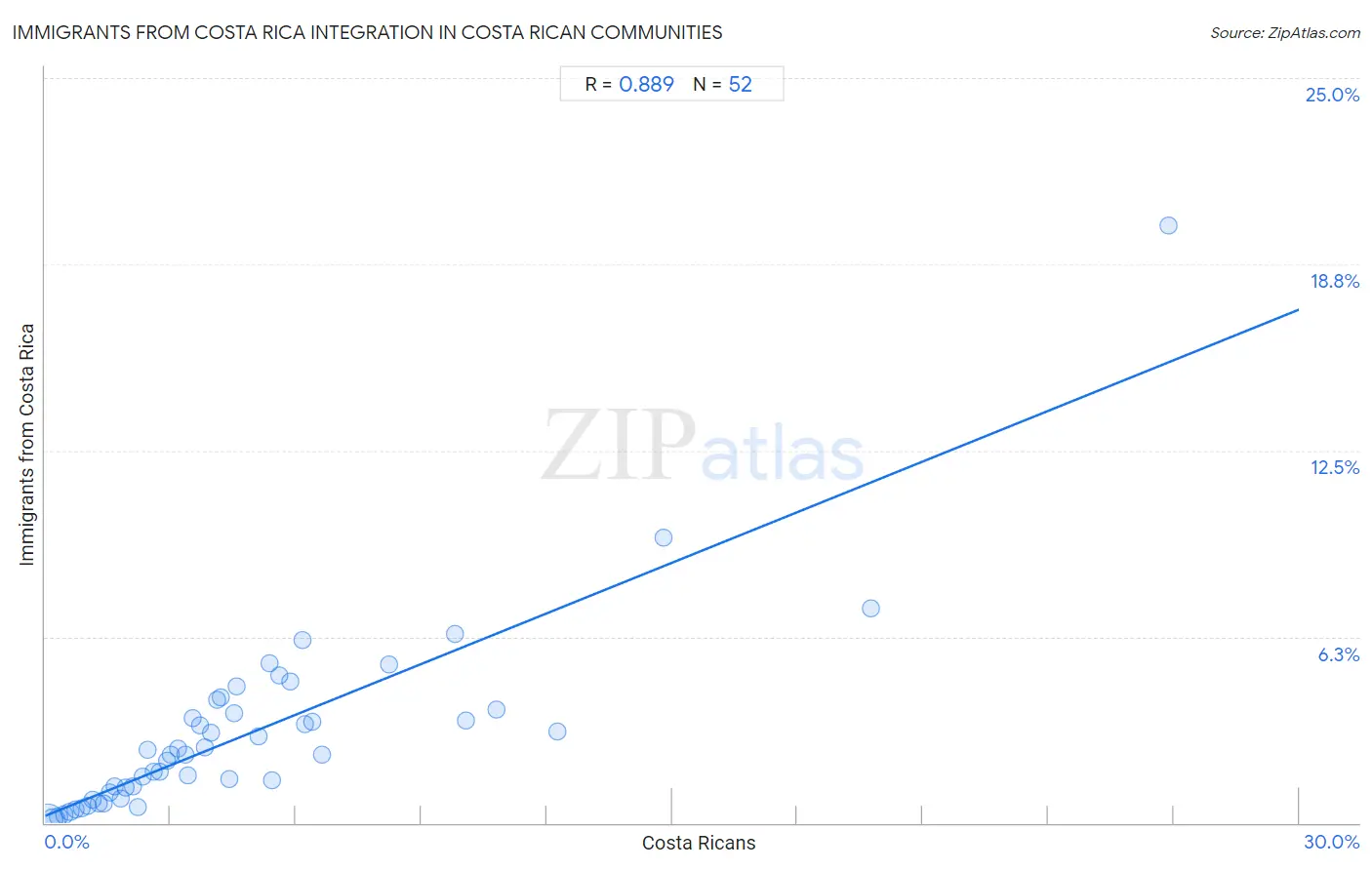
Difference between Costa Rican Ancestry and Immigrants from Costa Rica
While Costa Rican ancestry and immigrants from Costa Rica may have similarities, there are subtle differences that set them apart.
Costa Rican Ancestry
Costa Rican ancestry refers to a person's genetic, cultural, and historical connection to Costa Rica through their family lineage. This means that the person has Costa Rican heritage and is likely to share some characteristics and cultural traits that are associated with Costa Rica, such as language, customs, and traditions. It is possible to have Costa Rican ancestry without being an immigrant from Costa Rica.
Immigrant from Costa Rica
On the other hand, an immigrant from Costa Rica is a person who has moved from Costa Rica to the United States, with the intention of settling there. This person has left their country of origin and has become a citizen or resident of the United States. An immigrant from Costa Rica may or may not have Costa Rican ancestry, and their cultural background and identity may be influenced by a combination of their Costa Rican heritage and the culture of the United States.
Costa Rican vs Immigrants from Costa Rica Income
When considering income, the most significant differences between Costa Rican and Immigrants from Costa Rica communities in the United States are seen in householder income over 65 years ($61,638 compared to $59,848, a difference of 3.0%), householder income ages 25 - 44 years ($95,565 compared to $92,876, a difference of 2.9%), and householder income ages 45 - 64 years ($102,779 compared to $100,141, a difference of 2.6%). Conversely, both communities are more comparable in terms of householder income under 25 years ($53,106 compared to $52,643, a difference of 0.88%), median female earnings ($39,622 compared to $39,186, a difference of 1.1%), and per capita income ($44,090 compared to $43,464, a difference of 1.4%).
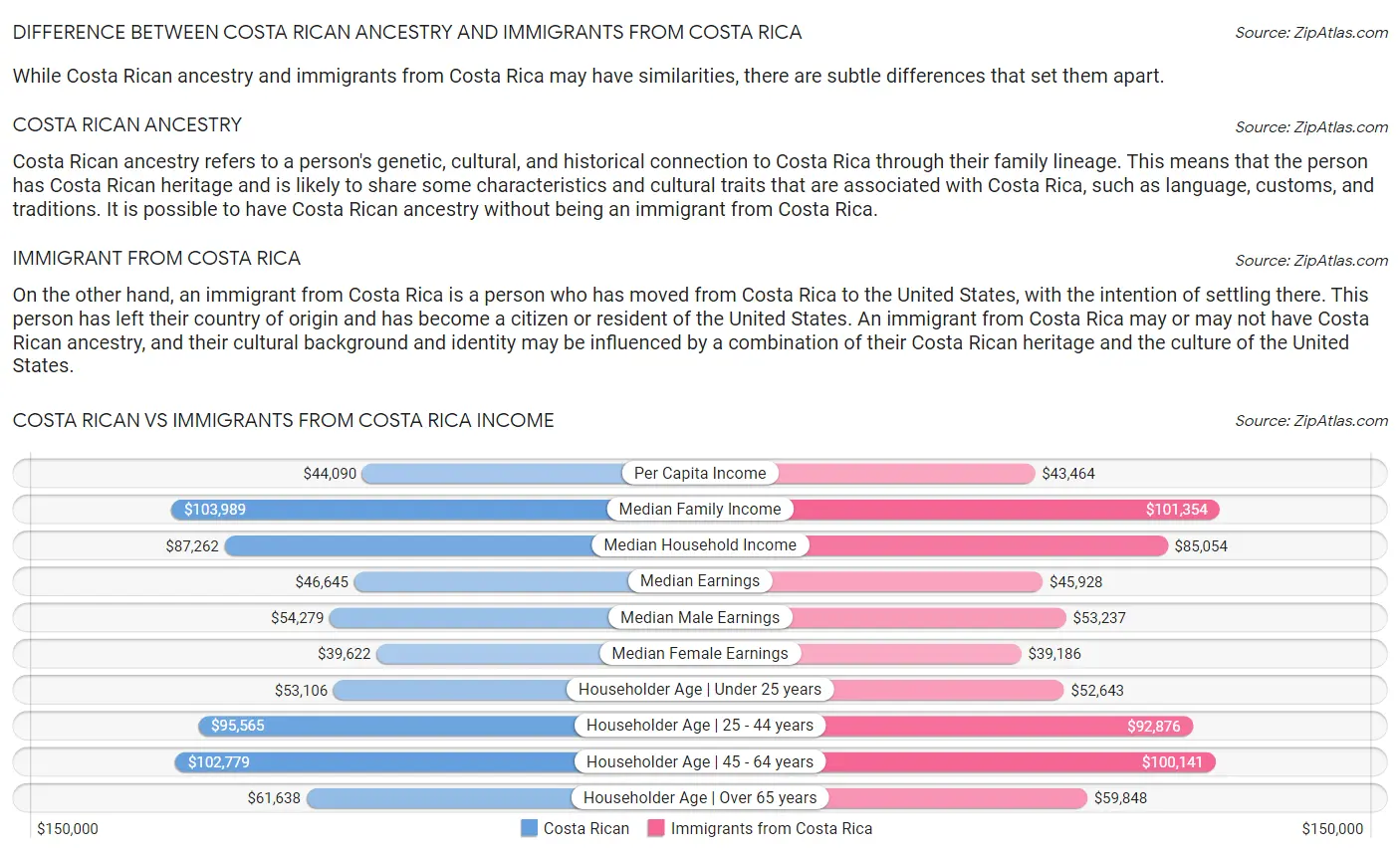
| Income Metric | Costa Rican | Immigrants from Costa Rica |
| Per Capita Income | Good $44,090 | Average $43,464 |
| Median Family Income | Good $103,989 | Fair $101,354 |
| Median Household Income | Excellent $87,262 | Average $85,054 |
| Median Earnings | Average $46,645 | Fair $45,928 |
| Median Male Earnings | Average $54,279 | Fair $53,237 |
| Median Female Earnings | Average $39,622 | Fair $39,186 |
| Householder Age | Under 25 years | Exceptional $53,106 | Good $52,643 |
| Householder Age | 25 - 44 years | Good $95,565 | Fair $92,876 |
| Householder Age | 45 - 64 years | Good $102,779 | Average $100,141 |
| Householder Age | Over 65 years | Good $61,638 | Fair $59,848 |
| Wage/Income Gap | Good 25.3% | Exceptional 24.7% |
Costa Rican vs Immigrants from Costa Rica Poverty
When considering poverty, the most significant differences between Costa Rican and Immigrants from Costa Rica communities in the United States are seen in married-couple family poverty (5.1% compared to 5.4%, a difference of 5.6%), receiving food stamps (11.6% compared to 12.2%, a difference of 4.9%), and child poverty among girls under 16 (16.2% compared to 17.0%, a difference of 4.8%). Conversely, both communities are more comparable in terms of single father poverty (16.3% compared to 16.3%, a difference of 0.090%), single mother poverty (29.0% compared to 29.2%, a difference of 0.47%), and female poverty among 18-24 year olds (18.8% compared to 18.7%, a difference of 0.70%).
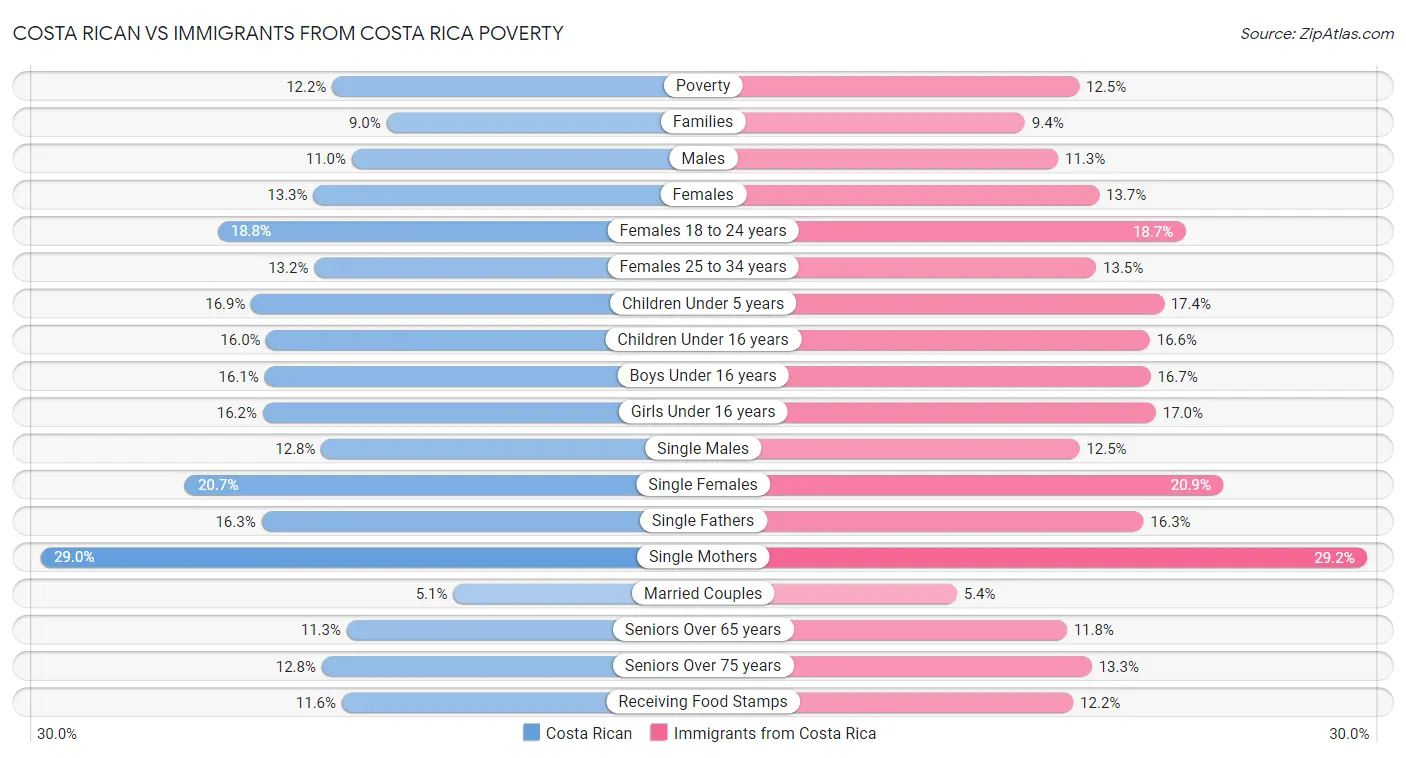
| Poverty Metric | Costa Rican | Immigrants from Costa Rica |
| Poverty | Good 12.2% | Fair 12.5% |
| Families | Average 9.0% | Fair 9.4% |
| Males | Good 11.0% | Fair 11.3% |
| Females | Good 13.3% | Fair 13.7% |
| Females 18 to 24 years | Exceptional 18.8% | Exceptional 18.7% |
| Females 25 to 34 years | Good 13.2% | Average 13.5% |
| Children Under 5 years | Good 16.9% | Fair 17.4% |
| Children Under 16 years | Good 16.0% | Fair 16.6% |
| Boys Under 16 years | Good 16.1% | Fair 16.7% |
| Girls Under 16 years | Good 16.2% | Fair 17.0% |
| Single Males | Average 12.8% | Excellent 12.5% |
| Single Females | Good 20.7% | Good 20.9% |
| Single Fathers | Average 16.3% | Average 16.3% |
| Single Mothers | Average 29.0% | Average 29.2% |
| Married Couples | Good 5.1% | Poor 5.4% |
| Seniors Over 65 years | Poor 11.3% | Tragic 11.8% |
| Seniors Over 75 years | Tragic 12.8% | Tragic 13.3% |
| Receiving Food Stamps | Average 11.6% | Fair 12.2% |
Costa Rican vs Immigrants from Costa Rica Unemployment
When considering unemployment, the most significant differences between Costa Rican and Immigrants from Costa Rica communities in the United States are seen in unemployment among seniors over 75 years (9.1% compared to 8.5%, a difference of 6.3%), unemployment among ages 65 to 74 years (5.4% compared to 5.6%, a difference of 3.4%), and unemployment among women with children under 18 years (5.5% compared to 5.6%, a difference of 3.3%). Conversely, both communities are more comparable in terms of unemployment among ages 25 to 29 years (6.7% compared to 6.7%, a difference of 0.42%), unemployment among ages 20 to 24 years (10.5% compared to 10.6%, a difference of 0.64%), and unemployment among youth under 25 years (11.9% compared to 11.8%, a difference of 0.71%).
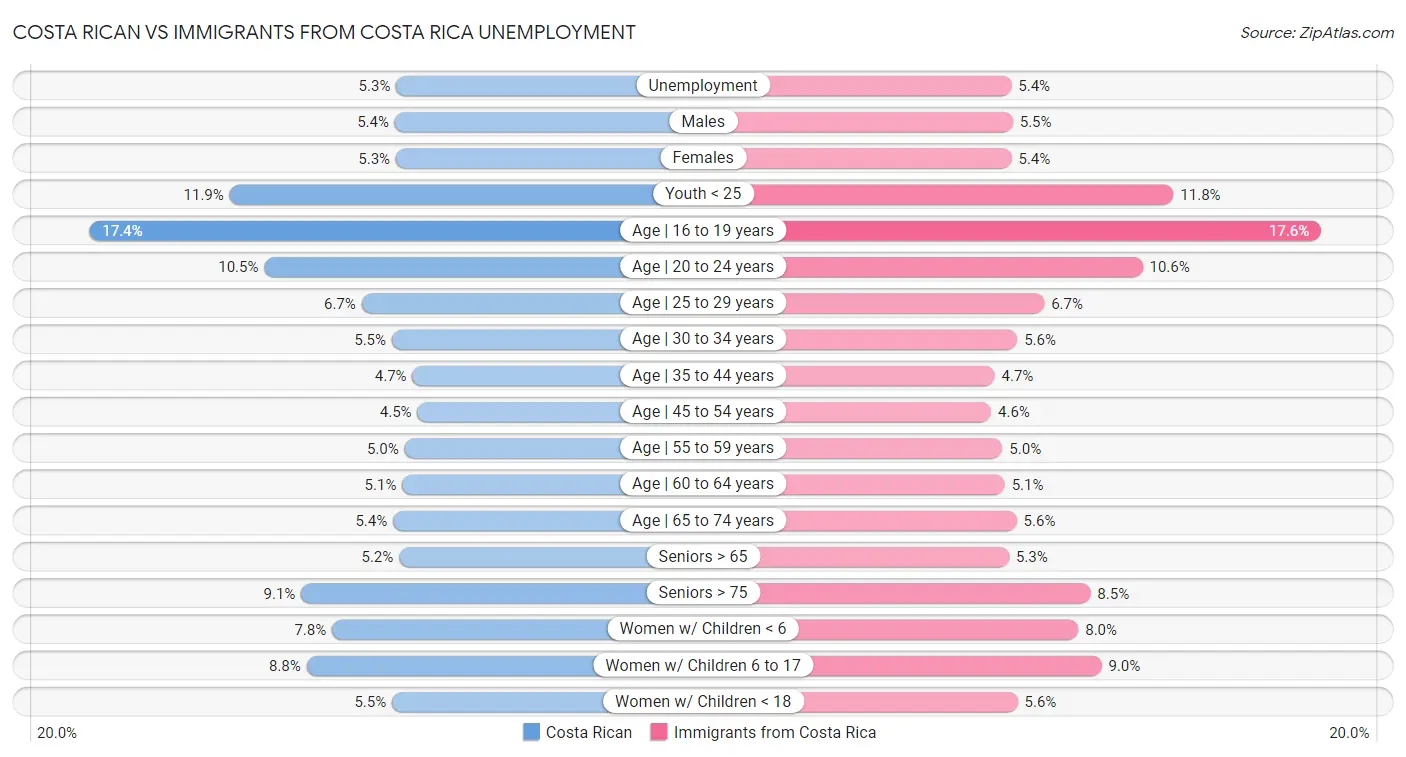
| Unemployment Metric | Costa Rican | Immigrants from Costa Rica |
| Unemployment | Fair 5.3% | Poor 5.4% |
| Males | Fair 5.4% | Poor 5.5% |
| Females | Fair 5.3% | Poor 5.4% |
| Youth < 25 | Tragic 11.9% | Poor 11.8% |
| Age | 16 to 19 years | Good 17.4% | Average 17.6% |
| Age | 20 to 24 years | Tragic 10.5% | Tragic 10.6% |
| Age | 25 to 29 years | Average 6.7% | Fair 6.7% |
| Age | 30 to 34 years | Average 5.5% | Poor 5.6% |
| Age | 35 to 44 years | Average 4.7% | Fair 4.7% |
| Age | 45 to 54 years | Good 4.5% | Poor 4.6% |
| Age | 55 to 59 years | Tragic 5.0% | Tragic 5.0% |
| Age | 60 to 64 years | Tragic 5.1% | Tragic 5.1% |
| Age | 65 to 74 years | Fair 5.4% | Tragic 5.6% |
| Seniors > 65 | Fair 5.2% | Tragic 5.3% |
| Seniors > 75 | Tragic 9.1% | Excellent 8.5% |
| Women w/ Children < 6 | Poor 7.8% | Tragic 8.0% |
| Women w/ Children 6 to 17 | Good 8.8% | Average 9.0% |
| Women w/ Children < 18 | Average 5.5% | Poor 5.6% |
Costa Rican vs Immigrants from Costa Rica Labor Participation
When considering labor participation, the most significant differences between Costa Rican and Immigrants from Costa Rica communities in the United States are seen in in labor force | age 16-19 (36.3% compared to 35.6%, a difference of 2.0%), in labor force | age 20-24 (75.2% compared to 74.9%, a difference of 0.41%), and in labor force | age 45-54 (82.8% compared to 82.6%, a difference of 0.20%). Conversely, both communities are more comparable in terms of in labor force | age 30-34 (84.6% compared to 84.5%, a difference of 0.050%), in labor force | age 20-64 (79.7% compared to 79.7%, a difference of 0.070%), and in labor force | age > 16 (65.6% compared to 65.5%, a difference of 0.090%).

| Labor Participation Metric | Costa Rican | Immigrants from Costa Rica |
| In Labor Force | Age > 16 | Exceptional 65.6% | Exceptional 65.5% |
| In Labor Force | Age 20-64 | Good 79.7% | Good 79.7% |
| In Labor Force | Age 16-19 | Fair 36.3% | Poor 35.6% |
| In Labor Force | Age 20-24 | Good 75.2% | Fair 74.9% |
| In Labor Force | Age 25-29 | Exceptional 85.0% | Exceptional 85.1% |
| In Labor Force | Age 30-34 | Fair 84.6% | Fair 84.5% |
| In Labor Force | Age 35-44 | Fair 84.3% | Poor 84.2% |
| In Labor Force | Age 45-54 | Average 82.8% | Fair 82.6% |
Costa Rican vs Immigrants from Costa Rica Family Structure
When considering family structure, the most significant differences between Costa Rican and Immigrants from Costa Rica communities in the United States are seen in single mother households (6.5% compared to 6.7%, a difference of 3.5%), single father households (2.3% compared to 2.4%, a difference of 2.2%), and births to unmarried women (32.7% compared to 33.4%, a difference of 2.0%). Conversely, both communities are more comparable in terms of average family size (3.26 compared to 3.26, a difference of 0.18%), family households with children (28.4% compared to 28.3%, a difference of 0.35%), and family households (65.9% compared to 65.6%, a difference of 0.49%).

| Family Structure Metric | Costa Rican | Immigrants from Costa Rica |
| Family Households | Exceptional 65.9% | Exceptional 65.6% |
| Family Households with Children | Exceptional 28.4% | Exceptional 28.3% |
| Married-couple Households | Excellent 47.2% | Average 46.3% |
| Average Family Size | Excellent 3.26 | Exceptional 3.26 |
| Single Father Households | Average 2.3% | Poor 2.4% |
| Single Mother Households | Fair 6.5% | Tragic 6.7% |
| Currently Married | Average 46.5% | Poor 46.0% |
| Divorced or Separated | Average 12.0% | Fair 12.2% |
| Births to Unmarried Women | Fair 32.7% | Tragic 33.4% |
Costa Rican vs Immigrants from Costa Rica Vehicle Availability
When considering vehicle availability, the most significant differences between Costa Rican and Immigrants from Costa Rica communities in the United States are seen in no vehicles in household (9.5% compared to 10.3%, a difference of 7.6%), 4 or more vehicles in household (6.8% compared to 6.5%, a difference of 4.9%), and 3 or more vehicles in household (20.6% compared to 19.7%, a difference of 4.4%). Conversely, both communities are more comparable in terms of 1 or more vehicles in household (90.5% compared to 89.8%, a difference of 0.83%), 2 or more vehicles in household (56.9% compared to 55.4%, a difference of 2.7%), and 3 or more vehicles in household (20.6% compared to 19.7%, a difference of 4.4%).

| Vehicle Availability Metric | Costa Rican | Immigrants from Costa Rica |
| No Vehicles Available | Exceptional 9.5% | Good 10.3% |
| 1+ Vehicles Available | Exceptional 90.5% | Average 89.8% |
| 2+ Vehicles Available | Exceptional 56.9% | Average 55.4% |
| 3+ Vehicles Available | Exceptional 20.6% | Good 19.7% |
| 4+ Vehicles Available | Exceptional 6.8% | Good 6.5% |
Costa Rican vs Immigrants from Costa Rica Education Level
When considering education level, the most significant differences between Costa Rican and Immigrants from Costa Rica communities in the United States are seen in no schooling completed (2.2% compared to 2.3%, a difference of 4.3%), doctorate degree (1.8% compared to 1.8%, a difference of 3.7%), and associate's degree (46.0% compared to 45.0%, a difference of 2.2%). Conversely, both communities are more comparable in terms of nursery school (97.8% compared to 97.7%, a difference of 0.090%), kindergarten (97.8% compared to 97.7%, a difference of 0.10%), and 1st grade (97.8% compared to 97.7%, a difference of 0.10%).
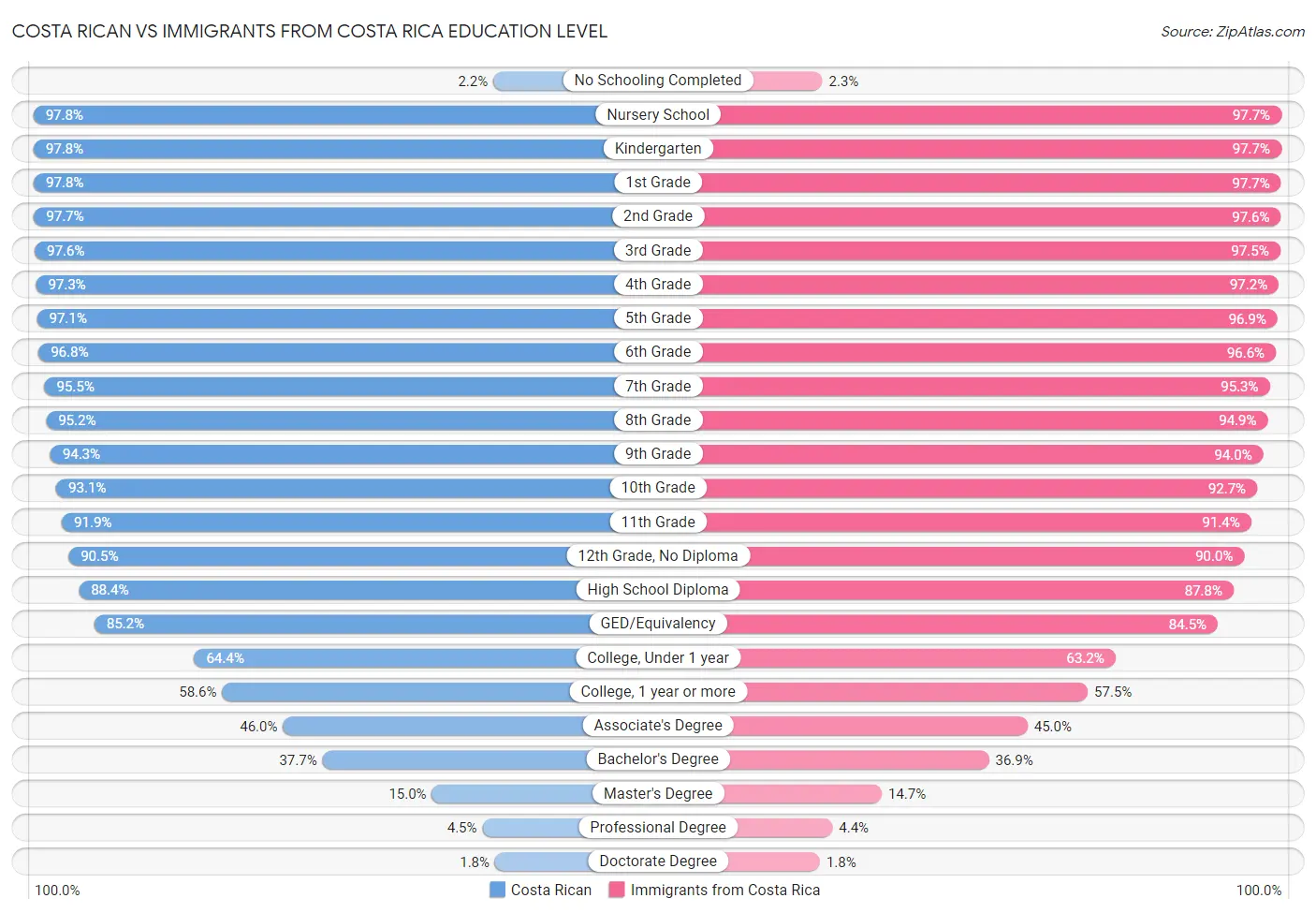
| Education Level Metric | Costa Rican | Immigrants from Costa Rica |
| No Schooling Completed | Poor 2.2% | Tragic 2.3% |
| Nursery School | Poor 97.8% | Tragic 97.7% |
| Kindergarten | Poor 97.8% | Tragic 97.7% |
| 1st Grade | Poor 97.8% | Tragic 97.7% |
| 2nd Grade | Poor 97.7% | Tragic 97.6% |
| 3rd Grade | Tragic 97.6% | Tragic 97.5% |
| 4th Grade | Tragic 97.3% | Tragic 97.2% |
| 5th Grade | Tragic 97.1% | Tragic 96.9% |
| 6th Grade | Tragic 96.8% | Tragic 96.6% |
| 7th Grade | Tragic 95.5% | Tragic 95.3% |
| 8th Grade | Tragic 95.2% | Tragic 94.9% |
| 9th Grade | Tragic 94.3% | Tragic 94.0% |
| 10th Grade | Tragic 93.1% | Tragic 92.7% |
| 11th Grade | Tragic 91.9% | Tragic 91.4% |
| 12th Grade, No Diploma | Tragic 90.5% | Tragic 90.0% |
| High School Diploma | Tragic 88.4% | Tragic 87.8% |
| GED/Equivalency | Fair 85.2% | Tragic 84.5% |
| College, Under 1 year | Poor 64.4% | Tragic 63.2% |
| College, 1 year or more | Fair 58.6% | Tragic 57.5% |
| Associate's Degree | Fair 46.0% | Poor 45.0% |
| Bachelor's Degree | Average 37.7% | Fair 36.9% |
| Master's Degree | Average 15.0% | Fair 14.7% |
| Professional Degree | Average 4.5% | Average 4.4% |
| Doctorate Degree | Average 1.8% | Fair 1.8% |
Costa Rican vs Immigrants from Costa Rica Disability
When considering disability, the most significant differences between Costa Rican and Immigrants from Costa Rica communities in the United States are seen in disability age under 5 (1.4% compared to 1.3%, a difference of 6.3%), hearing disability (2.9% compared to 2.9%, a difference of 1.8%), and disability age 5 to 17 (5.6% compared to 5.5%, a difference of 1.6%). Conversely, both communities are more comparable in terms of disability age 35 to 64 (10.7% compared to 10.7%, a difference of 0.060%), disability age over 75 (46.9% compared to 46.8%, a difference of 0.14%), and disability age 65 to 74 (22.6% compared to 22.6%, a difference of 0.19%).
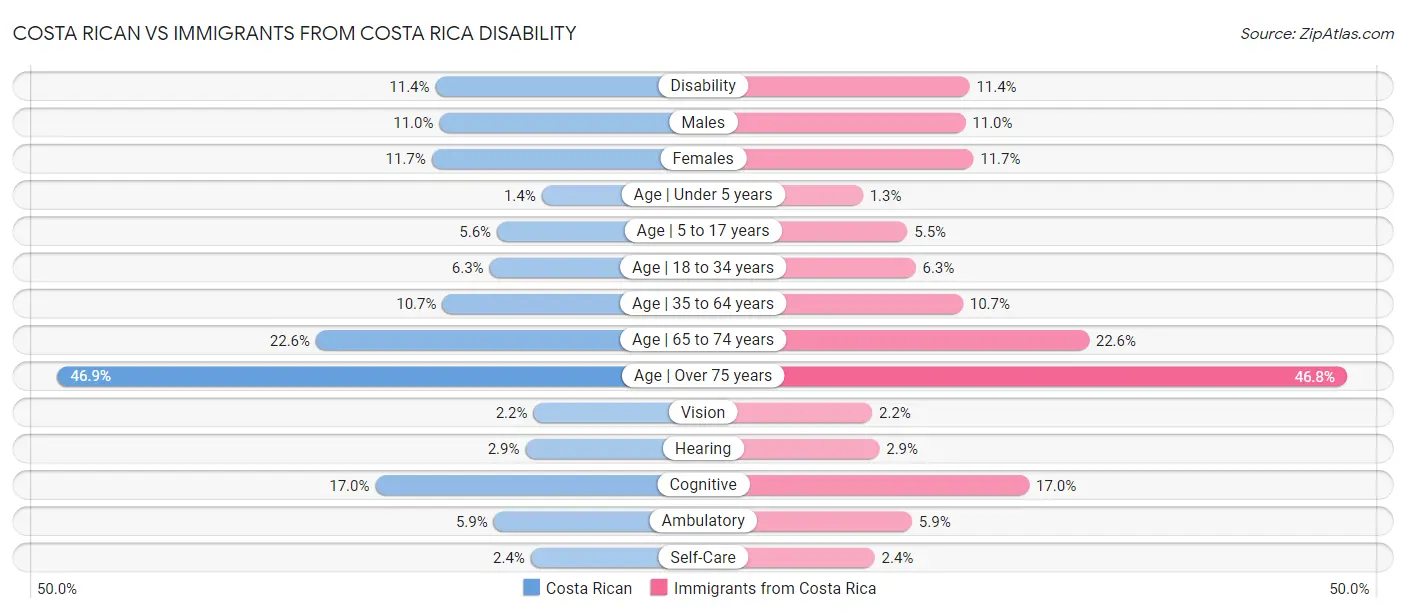
| Disability Metric | Costa Rican | Immigrants from Costa Rica |
| Disability | Exceptional 11.4% | Exceptional 11.4% |
| Males | Good 11.0% | Excellent 11.0% |
| Females | Exceptional 11.7% | Exceptional 11.7% |
| Age | Under 5 years | Tragic 1.4% | Tragic 1.3% |
| Age | 5 to 17 years | Average 5.6% | Good 5.5% |
| Age | 18 to 34 years | Exceptional 6.3% | Exceptional 6.3% |
| Age | 35 to 64 years | Exceptional 10.7% | Exceptional 10.7% |
| Age | 65 to 74 years | Excellent 22.6% | Exceptional 22.6% |
| Age | Over 75 years | Excellent 46.9% | Excellent 46.8% |
| Vision | Average 2.2% | Fair 2.2% |
| Hearing | Good 2.9% | Excellent 2.9% |
| Cognitive | Excellent 17.0% | Exceptional 17.0% |
| Ambulatory | Exceptional 5.9% | Excellent 5.9% |
| Self-Care | Excellent 2.4% | Good 2.4% |